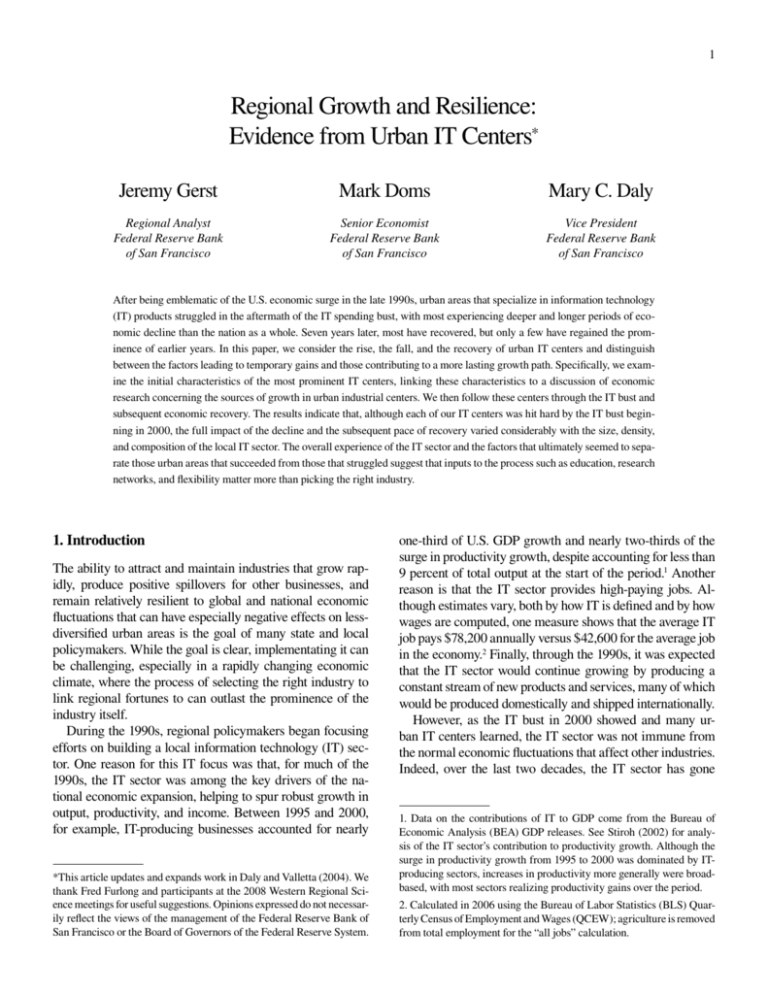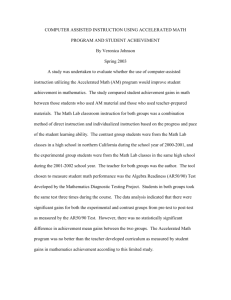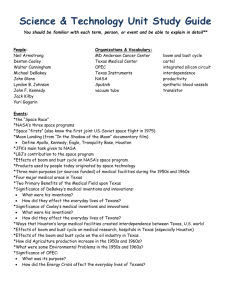Regional Growth and Resilience: Evidence from Urban IT Centers
advertisement

1 Regional Growth and Resilience: Evidence from Urban IT Centers* Jeremy Gerst Mark Doms Mary C. Daly Regional Analyst Federal Reserve Bank of San Francisco Senior Economist Federal Reserve Bank of San Francisco Vice President Federal Reserve Bank of San Francisco After being emblematic of the U.S. economic surge in the late 1990s, urban areas that specialize in information technology (IT) products struggled in the aftermath of the IT spending bust, with most experiencing deeper and longer periods of economic decline than the nation as a whole. Seven years later, most have recovered, but only a few have regained the prominence of earlier years. In this paper, we consider the rise, the fall, and the recovery of urban IT centers and distinguish between the factors leading to temporary gains and those contributing to a more lasting growth path. Specifically, we examine the initial characteristics of the most prominent IT centers, linking these characteristics to a discussion of economic research concerning the sources of growth in urban industrial centers. We then follow these centers through the IT bust and subsequent economic recovery. The results indicate that, although each of our IT centers was hit hard by the IT bust beginning in 2000, the full impact of the decline and the subsequent pace of recovery varied considerably with the size, density, and composition of the local IT sector. The overall experience of the IT sector and the factors that ultimately seemed to separate those urban areas that succeeded from those that struggled suggest that inputs to the process such as education, research networks, and flexibility matter more than picking the right industry. 1. Introduction The ability to attract and maintain industries that grow rapidly, produce positive spillovers for other businesses, and remain relatively resilient to global and national economic fluctuations that can have especially negative effects on lessdiversified urban areas is the goal of many state and local policymakers. While the goal is clear, implementating it can be challenging, especially in a rapidly changing economic climate, where the process of selecting the right industry to link regional fortunes to can outlast the prominence of the industry itself. During the 1990s, regional policymakers began focusing efforts on building a local information technology (IT) sector. One reason for this IT focus was that, for much of the 1990s, the IT sector was among the key drivers of the national economic expansion, helping to spur robust growth in output, productivity, and income. Between 1995 and 2000, for example, IT-producing businesses accounted for nearly *This article updates and expands work in Daly and Valletta (2004). We thank Fred Furlong and participants at the 2008 Western Regional Science meetings for useful suggestions. Opinions expressed do not necessarily reflect the views of the management of the Federal Reserve Bank of San Francisco or the Board of Governors of the Federal Reserve System. one-third of U.S. GDP growth and nearly two-thirds of the surge in productivity growth, despite accounting for less than 9 percent of total output at the start of the period.1 Another reason is that the IT sector provides high-paying jobs. Although estimates vary, both by how IT is defined and by how wages are computed, one measure shows that the average IT job pays $78,200 annually versus $42,600 for the average job in the economy.2 Finally, through the 1990s, it was expected that the IT sector would continue growing by producing a constant stream of new products and services, many of which would be produced domestically and shipped internationally. However, as the IT bust in 2000 showed and many urban IT centers learned, the IT sector was not immune from the normal economic fluctuations that affect other industries. Indeed, over the last two decades, the IT sector has gone 1. Data on the contributions of IT to GDP come from the Bureau of Economic Analysis (BEA) GDP releases. See Stiroh (2002) for analysis of the IT sector’s contribution to productivity growth. Although the surge in productivity growth from 1995 to 2000 was dominated by ITproducing sectors, increases in productivity more generally were broadbased, with most sectors realizing productivity gains over the period. 2. Calculated in 2006 using the Bureau of Labor Statistics (BLS) Quarterly Census of Employment and Wages (QCEW); agriculture is removed from total employment for the “all jobs” calculation. 2 FRBSF Economic Review 2009 from being emblematic of U.S. economic prowess—growing about four times more quickly than the overall U.S. economy—to leading the 2001 recession, to struggling to return to a sustainable, albeit slower, rate of growth. These fluctuations in growth produced large swings in IT employment. For instance, during the boom period of 1995–2000, IT employment grew at an average annual rate of 5.0 percent, nearly twice the average annual growth in total nonfarm employment of 2.6 percent during the same period. Similarly, in the bust period of 2000–2004, IT employment fell at an average annual rate of –5.0 percent, roughly 10 times the rate of –0.5 percent for total nonfarm employment over the same period. Since 2004, IT employment nationally has expanded by about 1.2 percent per year, compared to the 5.0 percent rate of growth experienced during the boom period. The considerable volatility experienced during these periods has prompted some key questions. For instance, how did individual regional IT centers fare during the boom, bust, and recovery periods? Why did some IT centers fare better than others? And what cities will be well positioned to take advantage of the next technology boom, whether it be in IT or some other field? In this paper we partially address these questions by analyzing a sample of 12 urban IT centers during the IT “boom and bust” cycle from 1995 to 2004, and through the lukewarm recovery period from 2004 to 2006. We find that performance across these IT centers has been quite heterogeneous, with some centers showing significant signs of recovery, others showing small signs of recovery, and others continuing to contract. The centers with a larger focus in IT services, rather than IT manufacturing, appear to have performed better, mirroring the trends observed in IT manufacturing and IT services nationally. All of these IT centers, however, possess the ability to be at the forefront of the next technology boom because of their highly skilled labor forces. The overall experience of the IT sector and the factors that ultimately seemed to separate urban areas that succeeded from those that struggled suggest that inputs to the process such as education, research networks, and flexibility matter more than picking the right industry. We begin in Section 2 by discussing our definition of IT and describing our sample of urban IT centers. In Section 3 we analyze the boom, bust, and recovery periods, examining the mixed performance across our IT centers. We then describe the national trends in IT, broken down into the subsectors of IT manufacturing and IT services in Section 4. This provides the background for discussing the relationship between employment gains, or losses, and a reliance on IT services versus manufacturing in Section 5. In Section 6 we discuss some of the underlying factors that help determine the formation and growth of urban IT centers, and in Section 7 we focus on one factor that especially unites all of the IT centers, that they all possess highly educated labor forces. Section 8 concludes. 2. IT Centers: Definition and Sample Before delving into our analysis of urban IT centers, it is important to define what is meant by information technology. Our broad definition of the IT sector is intended to capture the manufacture and service-based provision of advanced information technologies that rely on programming or other automated control mechanisms.3 On the manufacturing side, computers and communications equipment, and their primary building blocks—semiconductors and other advanced electronic machinery—form the core of this industry. IT manufacturing also includes the production of a variety of advanced measuring and testing equipment, such as photonics and electromedical and aeronautical devices, along with consumer electronics. The services side includes firms that provide wired and wireless communication technologies, along with deliverers of Internet and other computer programming, design, and management services, and research and engineering services. We use this broad definition wherever possible, although for much of what we study in this article, data constraints require that a narrower definition be applied. Notably excluded from this definition are the biotechnology and pharmaceuticals industries (biotech). These sectors share some of the key characteristics of our IT industries, most notably a knowledge-intensive production process, as reflected in an advanced skill base and extensive research and development (R&D) outlays and patenting activity. However, these industries tend to play a much smaller role than IT industries in local economies, and the demand and innovation cycles in these industries are independent of those in IT; for example, the biotech and pharmaceutical industries did not share in the recent boom-and-bust cycle experienced by our more narrowly defined providers of IT goods and services. These features of biotech support its exclusion from an analysis of the shifting fortunes of IT centers. With a definition of IT-producing industries in hand, we select a sample of urban areas where these industries play an important role. Geographically our definition of IT centers relies on the concept of metropolitan statistical areas (MSAs), as defined by the U.S. Office of Management and Budget and as used by federal statistical agencies. In general, MSAs consist of a core area containing a substantial population nucleus, together with adjacent communities that have a 3. The broad definition that we use is generally identical to the definition used by the American Electronics Association (see AEA 2003). It includes NAICS codes 33400, 333200, 333300, 511200, 51700, 518000, 541500, 541700, and 611400. Gerst, Doms, and Daly / Regional Growth and Resilience: Evidence from Urban IT Centers 3 high degree of socioeconomic integration with that core. To identify our IT centers, we apply the broadest available MSA definition, which in several cases corresponds to combined MSAs that form a “consolidated” MSA, or CMSA. Each of these areas is tied together internally by economic factors, such as commuting patterns and business ties, that form a shared economic base.4 We choose our exact set of cities by comparing the importance of the IT sector in the local economy to the importance of the IT sector in the national economy. Starting with a sample of 16 MSAs known to have large IT sectors or high IT shares of local activity (American Electronics Association 2000), we measure the importance of IT to the local economy by the share of IT industries in total nonfarm employment in 1995, 2000, and 2006.5 We keep any MSAs that had a larger share than the United States in at least two of the three years. The resulting list of 12 urban IT centers, shown in Table 1, is (in alphabetical order) Atlanta, Austin, Boston, Dallas, Denver, Los Angeles, Portland, Raleigh, Rochester, the San Francisco Bay Area, Seattle, and Washington, D.C. The four MSAs from the original 16 that are not included in our sample are Chicago, Minneapolis, New York, and Phoenix, each of which recorded shares of IT industries in total nonfarm employment below that of the United States in two or more years. 3. Performance of IT Centers Figure 1 displays the employment performance of our IT centers across the time periods of the boom (1995–2000), the bust (2000–2004), and the recovery (2004–2006). The bars in each figure depict the level changes in employment during these periods, as well as the cumulative change in employment across all periods (1995–2006) for each IT center. The boom, bust, and recovery periods are shown in black, while the cumulative change is shown on the right in gray. While all of the IT centers posted substantial gains in IT employment during the boom period, the bust varied greatly across IT centers; although all of the IT centers suffered declines in IT employment during the bust, some of the losses nearly or completely erased the gains made in the boom 4. For example, as indicated later in this section, rather than focusing narrowly on “Silicon Valley,” which corresponds roughly to the San Jose MSA in California, we include the San Francisco and Oakland MSAs in our definition of the San Francisco Bay Area IT center. Although the San Jose MSA traditionally exhibits the highest IT density of any MSA nationwide, San Francisco and Oakland also are relatively dense centers of IT activity, and the connections between IT and related firms throughout the region are strong (similar to the “Route 128” region in and around Boston). 5. We also measured the contribution of local IT sectors to national IT activity, which we report in the appendix Table A1. Table 1 Importance of IT: Shares of Local Employment Total IT share (%) IT share (%) excluding telecommunications Region 1995 1995 2000 2006 2000 2006 Atlanta 6.5 7.6 5.5 3.9 4.8 3.7 Austin 11.8 13.1 8.6 10.7 11.7 7.7 Boston 9.3 9.8 7.9 8.5 8.9 7.1 Dallas 8.1 9.1 6.5 6.2 6.5 4.8 Denver 8.5 10.8 7.4 6.2 7.8 5.6 Los Angeles 5.5 5.8 4.5 4.6 4.7 3.7 Portland 7.6 8.4 7.1 6.8 7.5 6.5 Raleigh 9.5 11.4 8.7 8.6 9.7 7.7 Rochester 8.2 9.2 7.3 7.4 7.9 6.1 S.F. Bay Area 13.3 16.2 13.0 12.0 14.8 12.1 Seattle 6.1 8.1 7.8 4.7 6.5 6.5 Washington, D.C. 8.3 10.2 9.3 6.8 8.5 8.1 United States 4.9 5.6 4.5 3.9 4.4 3.7 Source: Authors’ tabulations based on the U.S. BLS (QCEW). period, while in others the losses were less pronounced. Austin, Boston, Los Angeles, and Rochester shed more IT jobs in the bust period than they gained during the boom period. In Atlanta, Dallas, Denver, Portland, and the San Francisco Bay Area, the decline in IT employment during the bust period came close to negating the increases during the boom. However, in Seattle, Washington, D.C., and Raleigh, the losses during the bust were not as considerable as those experienced in the other IT centers, and much of the gains in IT employment made during the boom period were retained. The performance during the recovery period was especially mixed. Atlanta, Boston, Dallas, and Denver continued to experience slight declines in IT employment, while Austin, Los Angeles, Raleigh, Rochester, and the San Francisco Bay Area made very slight increases, especially when compared to the gains and losses experienced during the boom and bust. Portland, Seattle, and Washington, D.C., fared the best during the latest period, experiencing slightly larger relative gains in IT jobs. Overall, when we look across all time periods from 1995 to 2006, few IT centers made especially significant gains in IT employment. Seattle and Washington, D.C., posted the largest overall gains, retaining nearly all of the increases they experienced during the boom period. Portland and Raleigh fared comparably well also, overall maintaining roughly half of the gains they posted during the boom. However, Atlanta, Austin, Dallas, Denver, and the San Francisco Bay Area posted only slight overall gains, especially when compared to their meteoric increases during the boom. Moreover, Boston, Los Angeles, and Rochester suffered overall IT job losses between 1995 and 2006, owing to the significant 4 FRBSF Economic Review 2009 Figure 1 Change in Total IT Employment (in Thousands) Atlanta 50 Austin 30 40 20 30 20 10 10 0 0 –10 –10 –20 –20 –30 –40 95–00 00–04 04–06 95–06 40 20 0 –20 –40 –60 95–00 00–04 04–06 95–06 Portland 20 60 50 40 30 20 10 0 –10 –20 –30 –40 –50 04–06 95–06 –20 –60 95–00 00–04 04–06 95–06 –10 04–06 95–06 San Francisco Bay Area –20 40 100 30 50 0 –50 95–00 00–04 04–06 95–06 Seattle 50 150 20 –20 00–04 04–06 95–06 95–06 95–00 00–04 04–06 95–06 Washington, D.C. 80 40 –200 04–06 60 10 –10 00–04 100 20 –150 95–00 8 6 4 2 0 –2 –4 –6 –8 –10 –12 120 0 0 –100 95–00 Rochester –15 00–04 –80 Raleigh 0 95–00 Los Angeles –40 –5 –10 95–06 0 5 –5 04–06 20 10 0 00–04 40 15 5 95–00 80 20 10 Boston 60 25 15 200 00–04 Denver 60 –15 95–00 Dallas 80 –80 –30 50 40 30 20 10 0 –10 –20 –30 –40 –50 –60 –20 –40 95–00 00–04 04–06 95–06 –60 95–00 00–04 04–06 95–06 Gerst, Doms, and Daly / Regional Growth and Resilience: Evidence from Urban IT Centers 5 number of IT jobs they shed during the bust and their lackluster performance during the recovery. Figure 2 IT Employment in the United States 4. Performance of IT Services and Manufacturing Millions 2.0 There are many reasons why the differences across IT centers occurred. One of the contributing factors could have been the relative focus IT centers placed on the major subsectors of IT, services and manufacturing. Before examining the IT services/manufacturing split across IT centers, we first turn our attention to the national trends during the boom, bust, and recovery periods. Figure 2 shows the level change in IT employment for the United States separated into IT manufacturing and services. The trends shown in Figure 2 indicate a substantial gap between IT manufacturing and services in regards to their gains in employment. During the boom period the United States gained roughly 1.4 million jobs in IT industries. Of these gains in IT employment, 91.5 percent were made in IT services. This is because IT services grew much faster than IT manufacturing during this period, at an average annual rate of 8.2 percent compared with 1.2 percent, respectively), and because IT services make up a larger share of total IT employment in the United States. Conversely, during the bust, IT industries in the United States shed roughly 1.1 million jobs. Roughly 51 percent of this decline came from losses in IT manufacturing, despite the fact that it made up only 34.8 percent of total IT employment going into the bust in 2000. IT manufacturing’s weak performance in the boom and bust periods continued into the recovery period. Between 2004 and 2006, employment in IT manufacturing was basically stagnant, while IT services posted modest gains. Overall, between 1995 and 2006, IT services gained roughly 875,000 jobs, while IT manufacturing lost 462,000. This gap between IT manufacturing and IT services has considerable implications for our urban IT centers. We delve deeper into the performance of IT manufacturing and IT services in Table 2. In this table we examine the percent change, during the same four periods as in Figure 2, for the major subsectors of IT manufacturing and IT services. During the boom period, almost every subsector of IT services outperformed the subsectors of IT manufacturing, with the sole exception of scientific R&D. The largest gains in this period were made in the computer systems design, software, and Internet service providers and web search industries. With the exceptions of semiconductors and computers and peripherals, the gains in IT manufacturing were much more subdued. During the bust period there were sharp losses in all of the major subsectors of IT manufacturing, most notably for firms in the fields of communication equipment, audio and video, and semiconductors and electronics. Consistent with IT manufacturing IT services 1.5 1.0 0.5 0 –0.5 –1.0 –1.5 95–00 00–04 04–06 95–06 Table 2 Performance of IT Subsectors IT subsector Percent change in employment 95–00 00–04 04–06 95–06 Manufacturing Computers/peripherals Communication equipment Audio/video Semiconductor/electronics Electronic instruments Magnetic media 6.8 10.4 1.0 –5.2 20.1 –4.9 0.6 –27.2 –27.4 –41.0 –37.1 –33.4 –10.2 –27.0 –0.9 –6.6 –1.3 –5.0 1.5 1.4 –14.0 –22.9 –25.2 –41.2 –43.3 –18.7 –13.4 –36.8 Services Software publishers Telecommunications ISPs/web search portals Computer systems design Scientific R&D Technical training 48.1 69.6 31.6 63.9 81.3 12.7 43.8 –14.0 –11.3 –19.0 –25.3 –12.9 5.4 –13.5 4.1 3.3 –5.5 0.7 11.7 10.1 –1.8 32.6 55.4 0.7 23.3 76.4 30.7 22.2 Source: Authors’ tabulations based on the U.S. BLS (QCEW). the dot-com crash, the largest declines in IT services were for Internet service providers, followed by telecommunications. Software publishers suffered the smallest percent declines, while providers of scientific R&D actually made gains during this period. Gains in the recovery period were much more apparent for subsectors of IT services. Computer systems and design and scientific R&D posted substantial gains, while software publishers posted moderate gains and Internet service providers were fairly stagnant. Only the IT service subsectors of tele- 6 FRBSF Economic Review 2009 communications and technical training continued to experience job losses during the recovery period. Conversely, for IT manufacturing, only two subsectors recorded gains during the recovery period, semiconductors and electronics and electronic instruments. When looking across all periods, every subsector of IT services, with the exception of telecommunications, made significant gains in employment. The most notable gains were made by computer systems design and software publishers. The results for IT manufacturing are a stark contrast. Every subsector of IT manufacturing posted considerable declines between 1995 and 2006, though manufacturers of semiconductors and electronics and electronic instruments fared somewhat better than the other subsectors. 5. Explaining the Variance in Performance The discrepancy in performance between IT services and manufacturing can explain some of the variation in employment gains depicted in Figure 1 for our urban IT centers. In Table 3 we provide a look at the relative focus of our urban IT centers, and in Table 4 we refine our focus by excluding the outlier during the period, the telecommunications sector.6 The IT centers of Atlanta, Denver, Seattle, and Washington, D.C., all have a relative focus in IT services that is much larger than that of the nation. On the other hand, areas such as Austin, Boston, Portland, Raleigh, Rochester, and the San Francisco Bay Area are more heavily vested in IT manufacturing. Our results find that IT centers with a larger focus in IT services fared better, on average, than those with more of a focus in IT manufacturing. These results can be seen in Figure 3, a scatterplot of our IT centers depicting the relationship between an IT center’s relative focus and the percent change in IT employment these centers experienced. We plot IT services’ share of total IT employment in 2000 and the percent change in IT employment between 1995 and 2006. The fitted regression line is upward-sloping through the points, implying a positive relationship between the share of IT services and gains in employment. Similar results are shown in Figure 4, which excludes the telecommunications industry. Indeed, IT centers with a broad focus in IT services performed better than those with a primary focus in IT manufacturing. In fact, all centers with a share of IT services greater than the nation’s in 2000 experienced net employment gains in the overall IT sector between 1995 and 2006. 6. We provide separate results excluding telecommunications because, while the telecommunications industry is a large user of IT, it is not an IT producer. Consequently, the swings in the telecommunications industry (shown in Table 2) were largely driven by forces that were independent of the forces that affected the IT-producing sectors. Table 3 Composition Shares of IT Employment IT services (%) IT manufacturing (%) Region 1995 2000 2006 1995 2000 2006 Atlanta Austin Boston Dallas Denver Los Angeles Portland Raleigh Rochester S.F. Bay Area Seattle Washington, D.C. 80.3 17.6 39.8 51.2 74.6 43.4 37.7 38.7 25.8 41.0 77.6 83.2 85.5 30.4 50.8 61.8 80.1 53.0 38.8 46.3 39.1 52.6 81.9 88.0 88.1 37.0 60.3 66.0 81.5 54.4 38.7 52.7 42.2 57.5 85.6 90.4 19.7 82.4 60.2 48.8 25.4 56.6 62.3 61.3 74.2 59.0 22.4 16.8 14.5 11.9 69.6 63.0 49.2 39.7 38.2 34.0 19.9 18.5 47.0 45.6 61.2 61.3 53.7 47.3 60.9 57.8 47.4 42.5 18.1 14.4 12.0 9.6 United States 57.3 65.2 69.8 42.7 34.8 30.2 Source: Authors’ tabulations based on the U.S. BLS (QCEW). Table 4 Composition Shares of IT Employment (Excluding Telecommunications) Region IT services (%) IT manufacturing (%) 1995 2000 2006 1995 2000 2006 Atlanta 67.3 Austin 8.9 Boston 33.8 Dallas 36.3 Denver 64.8 Los Angeles 31.5 Portland 30.9 Raleigh 32.0 Rochester 17.1 S.F. Bay Area 34.2 Seattle 71.0 Washington, D.C. 79.5 77.1 22.0 45.6 46.7 72.2 42.5 31.3 37.0 29.8 48.2 77.3 85.5 82.4 29.2 55.9 54.6 75.5 45.3 33.1 46.8 31.4 54.5 82.7 89.0 32.7 91.1 66.2 63.7 35.2 68.5 69.1 68.0 82.9 65.8 29.0 20.5 22.9 78.0 54.4 53.3 27.8 57.5 68.7 63.0 70.2 51.8 22.7 14.5 17.6 70.8 44.1 45.4 24.5 54.7 66.9 53.2 68.6 45.5 17.3 11.0 United States 56.0 62.7 53.8 44.0 37.3 46.2 Source: Authors’ tabulations based on the U.S. BLS (QCEW). Seattle and Washington, D.C., which have some of the highest shares in IT services at 82 and 88 percent, respectively, experienced the largest percent gains in employment. Conversely, performance in IT centers with a large focus in IT manufacturing was much more mixed.7 Some, such as San Francisco and Raleigh, did post modest gains in IT employment, while others, such as Rochester and Boston, reported overall losses in IT employment. 7. A large focus in IT manufacturing is defined as those urban IT centers that have a larger share of IT manufacturing employment in total IT than the United States. See Table 3. Gerst, Doms, and Daly / Regional Growth and Resilience: Evidence from Urban IT Centers 7 Figure 3 IT Share vs. Change in Employment % change in IT employment 1995–2006 70 Seattle 60 50 Washington, DC 40 30 Raleigh 20 Portland 10 0 –10 –20 S. F. Bay Area Dallas L. A. Austin Rochester 0.3 Atlanta Denver Boston 0.4 0.5 0.6 0.7 0.8 IT services (2000) / Total IT employment (2000) 0.9 the percent gain Seattle made in software employment between 1995 and 2006 was roughly three times the percent gain in software employment made nationally over the same period. In contrast, Boston, with its large focus in computer and peripheral and semiconductor manufacturing, posted overall percent declines in IT employment. Similarly, semiconductor-focused Austin recorded somewhat weak percent gains in IT employment. An interesting case is the San Francisco Bay Area. In 1995, roughly 60 percent of Bay Area IT jobs were in manufacturing, while, at the national level, IT manufacturing jobs constituted about 43 percent of total IT employment. By 2006, however, the Bay Area IT sector had made strong gains in the IT service subsectors of Internet service providers and web search portal and computer systems design. As such, despite the downshift in IT manufacturing jobs, the Bay Area was still able to make overall gains in IT employment between 1995 and 2006. 6. The Determinants of Regional Resilience Figure 4 IT Share vs. Change in Employment (Excluding Telecommunications) % change in IT employment 1995–2006 80 Seattle 70 60 Washington, DC 50 40 30 20 Portland 10 S. F. Bay Area Raleigh Austin 0 Atlanta Denver L. A. Dallas –10 Rochester Boston –20 0.2 0.3 0.4 0.5 0.6 0.7 0.8 IT services (2000) / Total IT employment (2000) 0.9 These results bring out an important point, that the composition of the IT sector played a key role in determining the patterns of gains and losses in urban IT centers during these periods. Unfortunately, the detail in Table 2 for the nation is not generally available at the MSA level. However, where details are available, they provide some insights into the performance of individual MSAs. For instance, software-heavy Seattle and computer system design-intensive Washington, D.C., had the largest percent gains in IT employment, which is consistent with the national trends in these sectors. In fact, So far we have described where the IT sector has been concentrated and how the performance of IT centers has varied over time. Overall, we showed that IT centers that specialize more in IT services than in IT manufacturing fared better, on average, over the past decade, but that centers that were able to adjust to changes in demand, like the San Francisco Bay Area, were able to continue growing. In this section, then, we discuss what underlying factors determine the formation of urban IT clusters and their growth. We begin with a review of earlier work on the topic and conclude with more recent research examining the role of education in the development of urban growth centers. On the formation of specialized industry clusters, the work of Ellison and Glaeser (1997, 1999) is especially instructive. They note that Silicon Valley–style concentrations of industries can arise through two broad features of urban economies. The first is the presence of location-specific cost advantages—i.e., differences in input costs due to climate and geography, access to raw materials, and available supplies of different categories of labor. Although most inputs into the IT production process—financial capital, specialized machinery, raw materials, etc.—are unlikely to exhibit substantial price variation across geographic areas, variation in the availability and relative price of skilled labor (such as college-educated workers) may represent one important source of cost variation for IT producers. An additional mechanism for the development of specialized IT centers is the presence of beneficial knowledge spillovers among firms within the same industry and geographic area. To the extent that these “agglomeration economies” exist and contribute to local economic specialization, they cre- 8 FRBSF Economic Review 2009 ate the potential for “increasing returns” in production, or increased productivity in the locally concentrated industry as output increases. The tendency for initial industry leaders, such as Silicon Valley, to maintain or expand their innovative and productive edge over time is consistent with increasing returns in local IT centers. Moreover, this process of increasing returns through knowledge spillovers is likely to function most effectively in markets with an abundant supply of highly skilled labor, which suggests a potentially positive interaction between location-specific cost advantages and knowledge spillovers in determining IT industry growth. Saxenian (1994) has identified some of the key features of agglomeration economies in Silicon Valley’s IT sector, including knowledge transmission through employee mobility (often entrepreneurial), supportive and activist financial institutions (see Hellman and Puri (2002) for evidence on the role of venture capitalists), and the presence of knowledge centers such as research universities and institutes (see Audretsch and Feldman (1996) regarding the importance of knowledge spillovers from these sources). More general evidence, which systematically models growth performance across cities, also supports the importance of knowledge spillovers in urban IT centers. Beardsell and Henderson (1999) find strong evidence of positive spillovers at the local level in an analysis restricted to the computer industry. Moreover, Audretsch and Feldman (1996) find that industries in which knowledge spillovers are more prevalent have the greatest propensity to exhibit innovative clusters at the local level. Strictly speaking, Ellison and Glaeser’s arguments regarding the sources of localized growth refer to the degree of geographic concentration of total U.S. output in a sector, hence the overall size (rather than density) of local IT sectors in our setting. However, the benefits of agglomeration economies are likely to be most pronounced when production is locally dense (that is, constitutes a large share of output), since the benefits of knowledge spillovers may be diluted when the IT sector must compete more vigorously with other sectors for scarce knowledge resources. Thus, it is likely that specialization is important for IT sector growth, in the sense that an urban area must achieve a high density of IT activities as a share of overall economic activity in order to realize the benefits of agglomeration.8 Interestingly, other research finds that industrial diversity, rather than specialization, plays a key role in urban innovation and growth (see Feldman and Audretsch 1999, Duranton and Puga 2001).9 This is not necessarily inconsistent with the role of IT specialization, however, as it may also be true that diversity within the IT sector supports innovation. In particular, Duranton and Puga (2001) emphasize that innovative activities are most common and effective in diversified production environments, in which firms searching for the best products and processes benefit from a wide range of possibilities. The process of knowledge spillovers in the IT industry, achieved through employee mobility and related factors, functions as a critical delivery mechanism for realizing the benefits of diversified product environments. Duranton and Puga also note that it is common for firms to start up in diversified cities and then move to more specialized production locales; this is consistent with the tendency for IT firms to have headquarters in IT centers but to locate production facilities in lower-cost locations increasingly over time.10 Moreover, by ensuring a wide range of production processes and of products, a diverse local IT sector may possess the advantage of enhanced flexibility in response to changing conditions in IT markets; these may include changes in patterns of demand, changing domestic and overseas cost conditions, and other broad changes that affect the demand and supply for IT products and services. To summarize this previous research, it appears that urban areas that have a large IT sector and that have a relatively high density of IT activities may have two key advantages over other areas in regard to IT innovation and production. First, high IT density enables a region to capitalize on local increasing returns to IT innovation and production, thereby reducing costs and enhancing productivity within their IT sector. This is especially true when highly skilled labor is in abundant supply. In addition, having a large local IT sector increases the likelihood of diversity within the IT sector, since growth constraints related to market size are likely to be less binding when the product array is relatively broad. In addition to providing flexibility to respond to changing IT industry demand and cost conditions, diversity within the IT sector may provide an impetus for IT innovative activities by allowing firms to access a wide range of product and process options. As such, a combination of size and density in the IT sector may be optimal and go a long way towards explaining the continuity of an industry leader such as Silicon Valley. 8. Ciccone and Hall (1996) provide persuasive evidence that the density of overall economic activity in local economies, rather than their size, is a key determinant of economic growth. 10. For example, the growth of IT production and employment in Oregon and other relatively low-cost states over the past decade has occurred in part because existing companies, such as Intel, have relocated production facilities from high-cost areas, such as Silicon Valley, while maintaining research and management facilities in their cities of origin. 9. The importance of industrial diversity for urban growth is an idea often traced back to Jacobs (1969). 7. The Role of Education in Regional Resilience The previous section described theories about why IT sectors developed where they did and what factors gave certain areas Gerst, Doms, and Daly / Regional Growth and Resilience: Evidence from Urban IT Centers 9 an advantage. However, great uncertainty surrounds which IT centers will be positioned to do well in the future, especially in terms of which cities will continue to prosper as IT centers and which cities will be home to future information/ knowledge-based industries. Although numerous factors influence where certain industries prosper (including local government tax policies, proximity to suppliers and customers, et cetera), in this section we explore the potential importance of the education of the local labor force.11 As shown in Doms and Lewis (2006) and Beaudry, Doms, and Lewis (2006), cities vary tremendously in their educational attainment. One measure that is commonly used to compare average education levels is a concept called the “college-equivalent share.” The college-equivalent share measures the fraction of the full-time workforce that has at least four years of college plus one-half times the share of the workforce with at least some college.12 Figure 5 shows the college equivalent share for 100 of the largest CMSAs in 1980 and 2000.13 These cities include the 12 IT centers previously described, shown with solid markers. There are several items to note. First, cities vary tremendously in the education of their labor forces; the San Francisco Bay Area had a college equivalent share of 57 percent in 2000 compared to 31 percent for York, Pennsylvania. A second striking feature is the persistence in the college-equivalent share over time; the correlation between the college-equivalent share in 1980 and 2000 for the cities shown in Figure 5 is 89 percent. A third feature of note is that IT centers tend to be in highly educated cities. In fact, the 12 IT centers we study averaged a collegeequivalent share of 51 percent compared to 42 percent for the non-IT centers.14 There are many reasons why IT centers arose where they did, including historical legacies, local tax policies, and so forth. One of those reasons is likely to be the quality of the local labor force. That is, it may not be surprising that the IT centers prospered in highly educated areas, especially since the IT industry employs a relatively highly educated labor force. Using our measure of education, IT industries 11. Years of education is often used as a measure of the quality of the workforce because other measures of skill simply are not available over time and across cities. Although years of education is not a perfect measure of the quality of a local labor force, it is likely to be positively correlated with the quality of the labor force. For instance, cities that possess many college graduates are also likely to possess more entrepreneurs. 12. This is just one measure of education. However, the statements and results cited in this section are robust to a wide variety of definitions. 13. We choose to show years in which the decennial population census was conducted because detailed education and employment information is available for a large sample of cities in those years. 14. Tying the results here to the previous section, IT centers with higher education tended to have better employment performance than lesseducated IT centers. Figure 5 College Equivalent Share of Workforce 2000 % share 65 60 Raleigh Wash., DC S. F. Bay Boston Austin Area Seattle Denver Atlanta Rochester Portland Dallas St. Louis 55 50 45 Charlotte 40 L. A. Greenville Scranton 35 30 Reno Las Vegas Fresno Bakersfield York 25 15 20 25 30 35 1980 % share 40 45 Note: 100 largest CMSAs plotted. Black dots show 12 IT centers from our sample. tend to have highly educated workforces, with an average college-equivalent share of 61 percent compared to an average college-equivalent share of 47 percent for the entire U.S. workforce.15 One reason why cities can vary in their educational attainment arises from the industry and occupational structure of a city. For instance, a city with a large IT presence will have more highly educated workforces than cities with lower skill industries and jobs. However, the industry and occupational differences account for only a small fraction of the distribution observed in Figure 5. If that is so, then the question arises: Why are some cities more educated than others? There are likely many factors, so being able to say why one city is more educated than another is difficult. It is easier to say that education is correlated with a factor, such as having a large arts community or being close to an ocean, than to say that a factor “causes” a local labor force to be more highly educated. With that caveat in mind, Moretti (2004) finds that one important factor influencing why some cities are more educated than others is the presence of colleges and universities. These schools can raise the education of the local labor force for several reasons. First, having an abundance of higher education opportunities nearby increases the likelihood that the local population will take advantage of higher school15. This statistic is based on the 2000 decennial census for full-time workers. The highly educated nature of the IT labor force is apparent using other measures of education, such as average years of education, proportion of the workforce with more than a college degree, and so on. 10 FRBSF Economic Review 2009 ing. Second, after graduation, students may be inclined to stay near where they went to school. Finally, being near colleges and universities may be appealing to college graduates for the amenities provided. Whatever the reasons, it has been repeatedly found that cities with a relative abundance of colleges and universities may also have relatively highly educated workforces.16 Looking ahead, a natural question to ask is, Which cities will become the loci of the next knowledge-intensive industries? As stated, there are many reasons why one industry may be clumped in one area and not another. However, having highly educated workforces will likely be an important factor. 8. Summary This paper partially addresses the question of how various IT centers fared during the boom, bust, and lukewarm recovery period. We find that performance across these IT centers has been quite heterogeneous, with some centers showing significant signs of recovery, others showing small signs of recovery, and others continuing to contract. The IT centers with a larger focus on IT services, rather than manufacturing, appear to have performed better, mirroring the trends observed in IT manufacturing and IT services nationally. All of these IT centers, however, possess the ability to be at the forefront of the next technology boom because of their highly skilled labor forces. Regarding the original question raised in our paper, the results indicate that the more lasting contributors to regional growth and resilience are related to factors such as the education and skill level of the workforce, the diversity of the product base, innovative capacity, and ability to respond to changing conditions such as the recent rise in IT imports and overseas production. 16. An appealing approach of Moretti (2004), also used by Doms and Lewis (2006), is examining cities with land grant colleges. Land grant colleges were mostly established in the late 1800s and were not located in particularly highly educated areas. Therefore, the subsequent high education levels of land grant college cities are more likely to be due to the presence of the college. Appendix Table A1 Contribution of Local IT Employment to National IT Employment (Percent Shares) Local IT share (%) Local IT share (%) ex. telecommunications Region Atlanta Austin Boston Dallas Denver Los Angeles Portland Raleigh Rochester S.F. Bay Area Seattle Washington, D.C. 1995 2000 2006 1995 2000 2006 2.2 1.0 4.2 3.3 1.8 6.0 1.3 0.9 0.7 7.4 1.6 4.7 2.4 1.1 3.9 3.6 2.2 5.5 1.3 1.0 0.7 8.4 2.0 5.2 2.1 1.0 3.6 3.1 1.8 5.5 1.4 1.0 0.6 7.3 2.3 6.1 1.6 1.1 4.9 3.2 1.7 6.2 1.5 1.0 0.8 8.3 1.6 4.9 1.9 1.3 4.4 3.3 2.0 5.7 1.4 1.1 0.7 9.7 2.0 5.5 1.8 1.1 4.1 2.9 1.7 5.6 1.5 1.1 0.6 8.4 2.4 6.6 Source: Authors’ tabulations based on the U.S. BLS (QCEW). Gerst, Doms, and Daly / Regional Growth and Resilience: Evidence from Urban IT Centers 11 References American Electronics Association. 2000. Cybercities. Washington, DC. American Electronics Association. 2003. Cyberstates 2003. Washington, DC. Audretsch, David B., and Maryann P. Feldman. 1996. “R&D Spillovers and the Geography of Innovation and Production.” American Economic Review 86(3) (June) pp. 630–640. Beardsell, Mark, and Vernon Henderson. 1999. “Spatial Evolution of the Computer Industry in the USA.” European Economic Review 43(2) (February) pp. 431–456. Beaudry, Paul, Mark Doms, and Ethan Lewis. 2006. “Endogenous Skill Bias in Technology Adoption: City-Level Evidence from the IT Revolution.” FRB San Francisco Working Paper 2006-24. http:// www.frbsf.org/publications/economics/papers/2006/wp06-24bk. pdf Ciccone, Antonio, and Robert E. Hall. 1996. “Productivity and the Density of Economic Activity.” American Economic Review 86(1) (March) pp. 54–70. Daly, Mary, and Robert Valletta. “Performance of Urban Information Technology Centers: The Boom, the Bust, and the Future.” FRB San Francisco Economic Review 2004, pp. 1–18. http://www.frbsf. org/publications/economics/review/2004/er1-18bk.pdf Doms, Mark, and Ethan Lewis. 2006. “Labor Supply and Personal Computer Adoption.” FRB San Francisco Working Paper 2006-18. http://www.frbsf.org/publications/economics/papers/2006/wp0618bk.pdf Duranton, Gilles, and Diego Puga. 2001. “Nursery Cities: Urban Diversity, Process Innovation, and the Life Cycle of Products.” American Economic Review 91(5) (December) pp. 1,454–1,477. Ellison, Glenn, and Edward L. Glaeser. 1997. “Geographic Concentration in U.S. Manufacturing Industries: A Dartboard Approach.” Journal of Political Economy 105(5) (October) pp. 889–927. Ellison, Glenn, and Edward L. Glaeser. 1999. “The Geographic Concentration of Industry: Does Natural Advantage Explain Agglomeration?” American Economic Review 89(2) (May) pp. 311–316. Feldman, Maryann P., and David B. Audretsch. 1999. “Innovation in Cities: Science-Based Diversity, Specialization, and Localized Competition.” European Economic Review 43(2) (February) pp. 409–429. Hellman, Thomas, and Manju Puri. 2002. “Venture Capital and the Professionalization of Start-Up Firms: Empirical Evidence.” The Journal of Finance 57(1) (February) pp. 169–197. Jacobs, Jane. 1969. The Economy of Cities. New York: Random House. Moretti, Enrico. 2004. “Estimating the Social Return to Higher Education: Evidence from Longitudinal and Repeated CrossSectional Data.” Journal of Econometrics 121(1–2) (July/August) pp. 175–212. Saxenian, AnnaLee. 1994. Regional Advantage: Culture and Competition in Silicon Valley and Route 128. Cambridge, MA: Harvard University Press. Stiroh, Kevin. 2002. “Information Technology and the U.S. Productivity Revival: What Do the Industry Data Say?” American Economic Review 92(5) (December) pp. 1,559–1,576.









